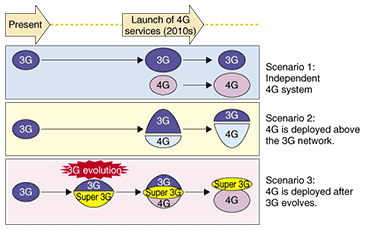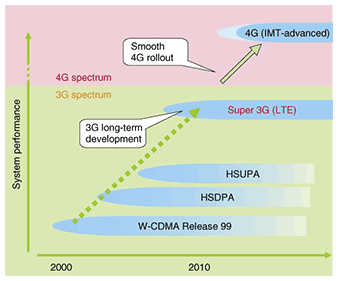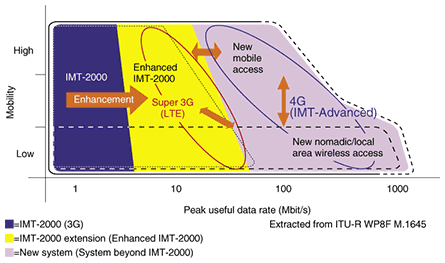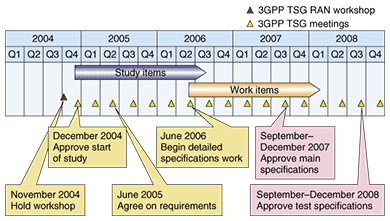 |
|||||||||||||||||||||||
|
|
|||||||||||||||||||||||
|
Special Feature: NGN Mobile Communication Technologies for Large-capacity and High-efficiency Communications in the Flat-rate Era Vol. 6, No. 11, pp. 5–9, Nov. 2008. https://doi.org/10.53829/ntr200811sf4 Standardization Trend for Super 3G (LTE)AbstractSuper 3G (also known as Long Term Evolution (LTE)) expands upon the HSDPA/HSUPA (high-speed downlink/uplink packet access) extension technologies of the wideband code division multiple access (W-CDMA) system to provide elemental technologies for further reduction of bit cost toward a flat-rate system. This article introduces global trends toward the standardization and commercialization of Super 3G.
1. IntroductionThe commercial deployment of the wideband code division multiple access (W-CDMA) system is progressing steadily not only in Europe but in North America and Asia as well, and at present, more than 180 mobile network operators have commenced 3rd-generation (3G) services using W-CDMA. Today, the maximum downlink transmission data rate provided by NTT DOCOMO in its packet services via high-speed downlink packet access (HSDPA*1) is 7.2 Mbit/s, but the technical specifications of HSDPA and high-speed uplink packet access (HSUPA*2) support maximum transmission data rates between a base station and mobile terminals of 14 Mbit/s in the downlink and 5.7 Mbit/s in the uplink. These technologies can improve not only the data transmission rate but also spectrum efficiency, thereby reducing the cost per bit. At the same time, data traffic and content capacity are increasing rapidly while the demand for lower rates or a flat rate is rising. The further reduction of bit cost has become a major issue in dealing with these developments. To ensure a long lifespan for 3G, NTT DOCOMO proposed the “Super 3G” concept in 2004. Super 3G expands upon the HSDPA/HSUPA extension technologies of the W-CDMA system. It is called Long Term Evolution (LTE*3) within the 3rd-generation Partnership Project (3GPP*4). Super 3G (LTE) aims to achieve the following three main features by adopting various new technologies.
In addition to reducing the cost per bit by improving spectrum efficiency, Super 3G (LTE) can achieve low delays and faster speeds enabling the provision of services with strict delay requirements and the transmission of large files.
2. Super 3G (LTE) trends2.1 Super 3G objectives and scopeIt is thought that the introduction of HSDPA is one way of enabling 3G mobile communication systems that use W-CDMA technology to satisfy market needs and to maintain competitiveness with other systems over a number of years. However, to deal effectively with multimedia and ubiquitous traffic, which is expected to grow in the years to come, there will be a need for long-term technology evolution including the 4th generation (4G). A number of proposals have been studied as long-term migration scenarios to 4G, and it has been decided that the optimal one is to begin by extending 3G and then constructing 4G on top of that extension (Fig. 1). Against this background, NTT DOCOMO put forward the Super 3G concept as a migration scheme for the mobile system [1].
In addition to facilitating a smooth migration to 4G, Super 3G aims to maintain the long-term competitiveness of the W-CDMA system by expanding 3G (Fig. 2) [2]. Super 3G will be required to provide short delays in addition to a dramatic jump in data rates and improved spectrum efficiency. Achieving short delays means that the time required for call setup (connection delay) and the time involved in data transfer during a call (transmission delay) will be reduced, enabling high-speed data transmission by a protocol like TCP/IP (transmission control protocol, Internet protocol).
At ITU-R (International Telecommunication Union, Radiocommunication Sector), where the future outlook of mobile communications is discussed, approval was given in 2003 for Recommendation M.1645 entitled “Framework and overall objectives of the future development of IMT-2000 and system beyond IMT-2000”. This recommendation includes a graph depicting the relationship between mobility and data rate (Fig. 3). In the figure, IMT-2000 (International Mobile Telecommunications-2000) corresponds to 3G, while the new capabilities of the system beyond IMT-2000 correspond to 4G, now called IMT-Advanced at ITU-R. Here, Super 3G (LTE) is an extension of IMT-2000 and is consequently included within the framework of IMT-2000.
For 4G (IMT-Advanced), new spectrum is expected to be allocated to increase the bandwidth and allow even higher data rates to be achieved, but Super 3G (LTE) will use spectrum that includes additional bands allocated for IMT-2000. Super 3G is therefore a system that will use the 3G spectrum, but it is being studied taking into account the capability of using 5 MHz (as used by W-CDMA) and higher bandwidths for more flexible operation. It is also assumed that the amount of facility investment and operational expenses for deploying Super 3G will be moderate and appropriate, and to this end, the target must be simple and inexpensive system construction rather than the complexity of the system architecture for the radio network and mobile terminals. 2.2 Standardization trendsReflecting the urgent need to study the development of the 3G long-term evolution system, a workshop entitled “3G RAN LTE”*5 was held in November 2004 by the TSG (Technical Specification Group) RAN technical body in 3GPP. The Super 3G concept was proposed by NTT DOCOMO at this workshop, and after support was obtained from 26 companies, LTE studies within 3GPP were proposed and agreed upon. The standardization schedule at 3GPP is shown in Fig. 4. A technical report (TR25.913) [3] related to requirements was approved in June 2005, while a technical report (TR25.912) [4] issued upon completion of the basic studies, including feasibility considerations, was approved in June 2006. The preparation of detailed technical specifications then commenced, followed by the approval of main specifications in the period from September to December 2007. From here on, the plan is to complete detailed specifications and to prepare specifications toward the completion of test specifications scheduled for the end of 2008.
2.3 Global trends and development scheduleNext-generation mobile networks (NGMN) [5] is an organization that provides the views of mobile communications operators and promotes standardization to study the requirements for mobile communications beyond 2010. As of May 2008, 18 operators and 28 vendors are participating in NGMN. Super 3G (LTE) is one of the technologies targeted for study here and the most promising. In addition, the LTE/SAE Trial Initiative (LSTI) organization (SAE: system architecture evolution), which aims to achieve early deployment of Super 3G (LTE) commercial services, is testing Super 3G (LTE) performance using verification test equipment and conducting tests for early stabilization of interoperability between multiple vendors amongst other activities. The goal here is to complete commercial system development around 2009–2010. NTT DOCOMO's development schedule is shown in Fig. 5. The development of Super 3G began upon the completion of basic studies in June 2006, and indoor experiments began using trial equipment in July 2007. Field trials then began in February 2008 as tests toward practical deployment including the verification of important functions like handover and further optimization of the system. The objective is to complete commercial system development in 2009. This schedule is consistent with LSTI targets.
3. ConclusionIn this article, we outlined the Super 3G (LTE) system planned for commercialization with the aim of achieving a significant reduction in cost per bit. References
|
|||||||||||||||||||||||














